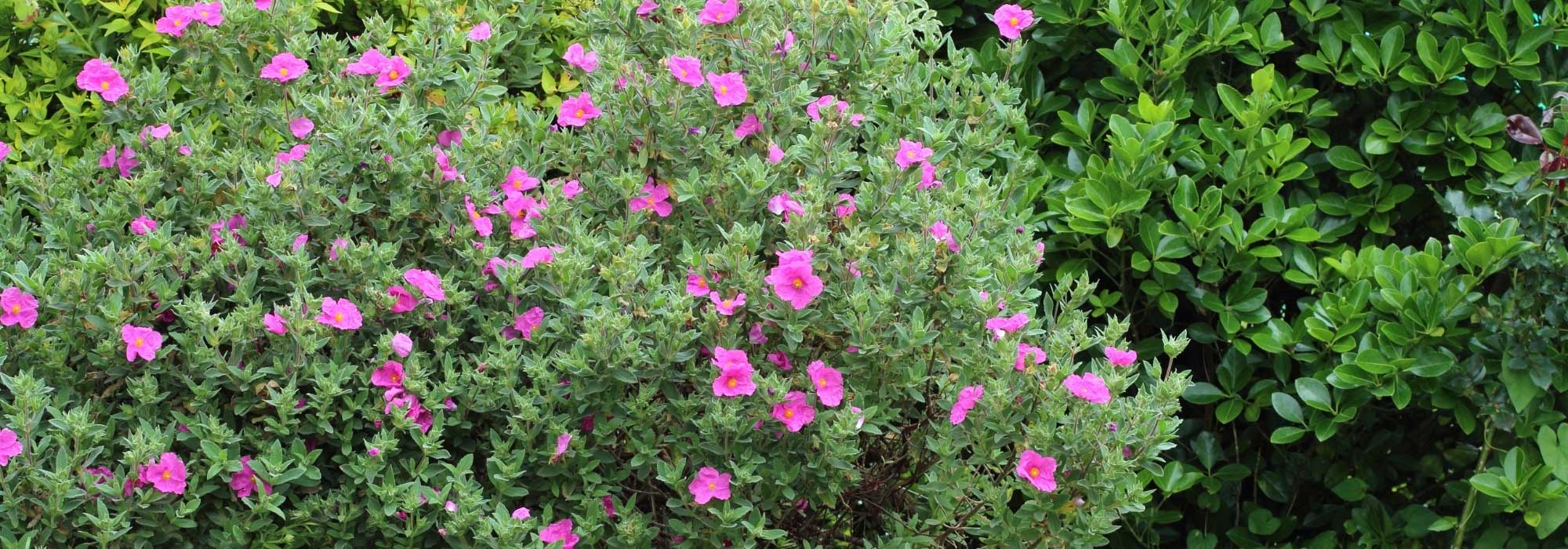
Cistus: beautiful pairing ideas
7 pairing ideas to enhance rockrose
Contents
The cistus is perhaps the plant that most evokes the spirit of the garrigue: it is highly resistant to extreme soil and drought conditions, while its flowers appear so delicate! It naturally grows on soils severely degraded by erosion and grazing, and being pyrophytic (which takes advantage of fire to germinate), it sometimes naturalises over large areas after a fire. These shrubs are therefore magnificent allies for gardeners in Mediterranean climates, where gardening conditions are among the most challenging: the poorer and more drained the soil, the more magnificent the cistus will be! No fertiliser or potting soil is needed at planting: just some stones and a bit of garden soil will suffice. The choice is vast within this large family, and if you wish to showcase them, here is a selection of our cistus collection and some ideas for combinations.
In a seaside garden
Some rockroses grow spontaneously along the Mediterranean coast. They are not afraid of the sea spray and adapt very well! In a seaside garden, Cistus x purpureus with its deep pink flowers and Cistus skanbergii featuring a multitude of small soft pink flowers will harmonise particularly well with Lavatera maritima and Convolvulus cneorum, a silver groundcover with pure white flowers. These rockroses have a bushy growth habit: the purple rockrose will reach 1m in all directions, while Cistus skanbergii will be a bit more compact and spreading, yet dense. The spindle tree Euonymus japonicus ‘Président Gauthier’, a light green evergreen bush variegated with cream, will structure this bed and highlight the intense blue flowering of Ceratostigma willmottianum ‘Forest Blue’ from July to November. The palm Washingtonia filifera will serve as a backdrop, dominating the scene with its tall silhouette and enhancing the seaside atmosphere of the garden.
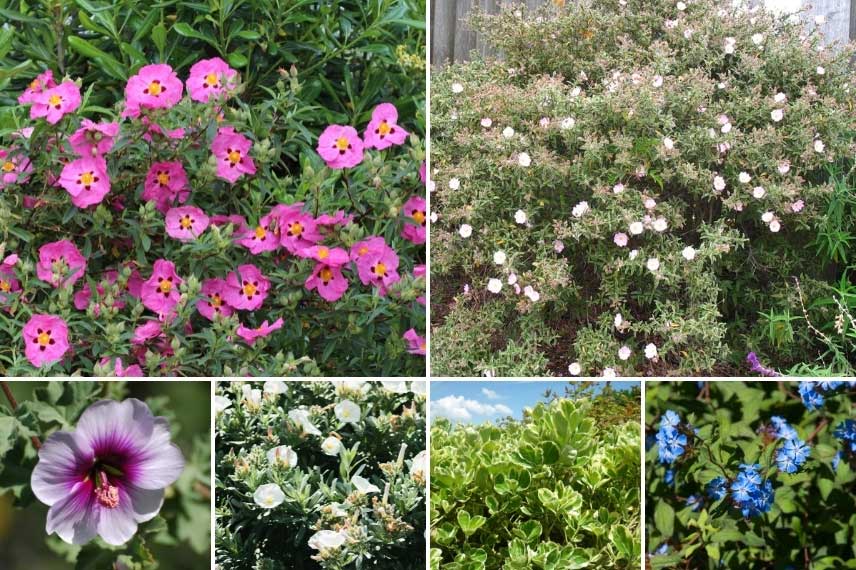
Cistus x purpureus and Cistus skanbergii in bloom in spring, Lavatera maritima flowering from June to October, Convolvulus cneorum flowering from April to August, Euonymus japonicus ‘Président Gauthier’ and Ceratostigma willmottianum ‘Forest Blue’, which flowers from July to November
In a dry gravel garden
The dry garden is, of course, the ideal place to plant a multitude of cistus. If possible, the planted areas should be raised to ensure drainage and covered with gravel mulch. The Cistus argenteus ‘Peggy Sammons’ will brighten the garden with its lovely soft pink flowers featuring golden stamens that will renew daily from May to June. This shrub, with a bushy habit, grows to 1.20m and bears small evergreen leaves. Provide it with well-drained soil conditions, and you will hardly need to maintain it, unless you wish to keep a compact habit by lightly trimming it in early autumn. Pair it with the silver foliage of the wormwood Artemisia arborescens ‘Little Mice’, along with rosemaries, santolines, lavenders and Perovskia, this Mediterranean-style garden will be attractive throughout the year and very easy to maintain!

Clockwise: gravel garden featuring the blue flowering of Perovskia, Cistus argenteus ‘Peggy Sammons’ in bloom from May to June, grey foliage of Artemisia arborescens ‘Little Mice’, rosemary, santolines, and lavenders
Discover other Cistus - Rockrose
View all →Available in 1 sizes
Available in 2 sizes
Available in 2 sizes
Available in 1 sizes
Available in 0 sizes
Available in 1 sizes
Available in 1 sizes
Available in 1 sizes
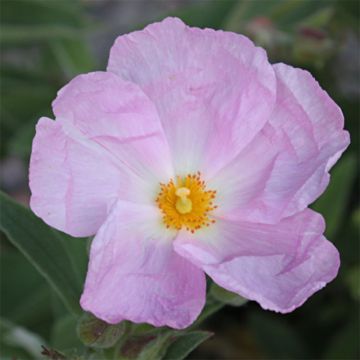
Available in 1 sizes
Available in 1 sizes
In an allelopathic garden
Allelopathic plants have the unique ability to produce biochemical substances that inhibit the germination and/or growth of other plants. If you observe the soil beneath and around them, there are virtually no adventive plants, commonly referred to as “weeds.” An allelopathic garden requires almost no maintenance once the plants are established. Cistus belong to this category of plants, and here they are associated with other species that share this characteristic and tolerate the same growing conditions. We will pair Cistus creticus, bright pink, or Cistus (x) loretii, pure white with a purple-spotted heart, both flowering from April to June, with Achillea millefolium ‘Heinrich Vogeler’, which has lovely small bouquets of white flowers from June to September, and Centaurea bella. Then, Ballota pseudodictamnus, with its soft grey foliage and pretty pink inflorescences from July to September, will take over along with the curry plant: Helichrysum italicum. The Myrtus communis ‘Tarentina’ will form the backbone of the display: an aromatic evergreen bush, it grows slowly to just over 1.5m and also flowers from July to September.
 From April to June: Cistus creticus, bright pink, and Cistus (x) loretii, pure white with a purple-spotted heart, fluffy leaves of Ballota pseudodictamnus, Helichrysum italicum, and Myrtus communis ‘Tarentina’
From April to June: Cistus creticus, bright pink, and Cistus (x) loretii, pure white with a purple-spotted heart, fluffy leaves of Ballota pseudodictamnus, Helichrysum italicum, and Myrtus communis ‘Tarentina’
Read also
Sowing rockroseIn a melliferous garden
Attracting Bees to the Garden to Promote Biodiversity! Tested by pesticidal challenges, hornets are taking advantage of globalisation to expand their hunting grounds across the planet (well, perhaps not to the Poles…), alongside habitat loss and monocultures, bees and all kinds of pollinating insects need the help of gardeners. If you fear them (unjustly, as they are generally not aggressive), reserve a small, quiet corner of your garden for them. Cistus are highly appreciated by bees: for example, pair the stunning Sage-leaved Cistus Cistus salviifolius, which displays a multitude of small white flowers from April to June, with the Powdery Cistus Cistus pulverulentus and the Winter Honeysuckle Lonicera fragrantissima, which delights bees from December to March, when most other flowers are absent. The Choisya ternata, or Mexican Orange Blossom, is also melliferous. Its flowers are beautifully fragrant and bloom in spring, often continuing into September. And of course, plant the essential Lavenders and Perovskia, such as Lavandula intermedia ‘Dutch group’ and Perovskia atriplicifolia ‘Blue Steel’. Ultimately, you will enjoy this little flowering corner and live in perfect harmony with the bees!
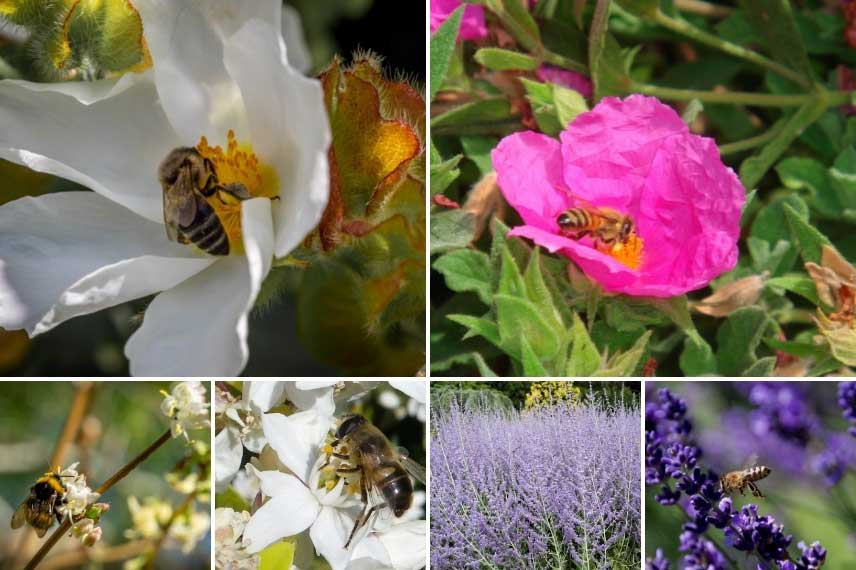
In spring: white flowers of Cistus salviifolius and bright pink flowers of Cistus pulverulentus. Flowers of Lonicera fragrantissima from December to March, flowers of Choisya ternata in spring. Perovskia and Lavenders blooming all summer
Under the cover of trees
Vegetating an area of woodland can sometimes be a bit tricky: shade, root competition… While cistus generally prefer to make the most of the sun’s rays, there are some more tolerant varieties that naturalise in the light understorey of pine forests or oak woodlands, for example. Thus, the Cistus salviifolius thrives in this type of environment. It flowers from April to June and has a rather spreading habit, reaching a height of 90 cm with a spread of just over 1 m. Its rough, dark green leaves are evergreen. The Acanthus mollis, with its graphic habit, also enjoys similar conditions, along with the creeping Plumbago Ceratostigma plumbaginoïdes, which boasts stunning intense blue flowers from August to October. To complete a sparse understorey, let the Algerian Irises Iris unguicularis naturalise, brightening the winter with their long lilac and yellow flowering from January to March!
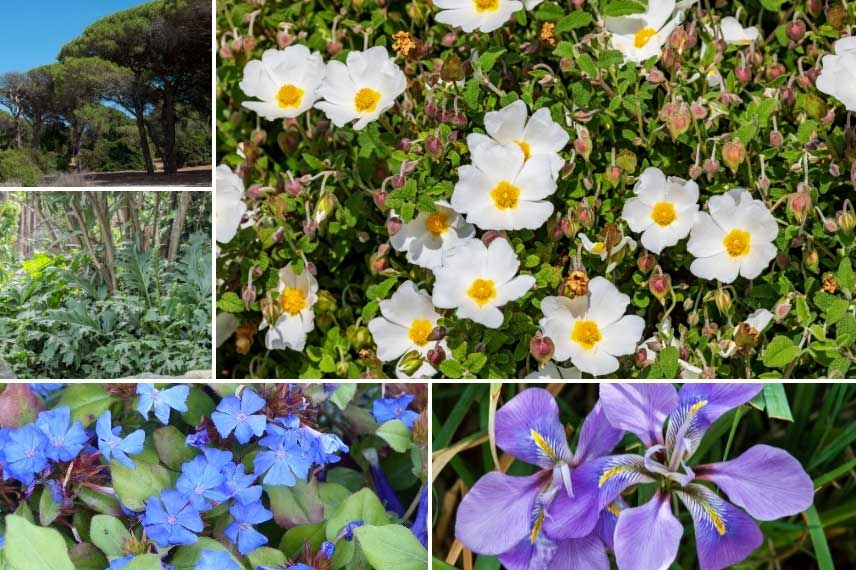
Dry understorey area. Below: Acanthus mollis. Top right: Cistus salviifolius. Bottom left to right: flowers of Ceratostigma plumbaginoïdes from August to October and flowers of Iris unguicularis in winter
In an acid soil garden
Rockroses can have very different tolerances to lime depending on the species and varieties chosen. Thus, Cistus ladanifer and Cistus creticus are among the acidophilous rockroses, meaning they prefer acid soil. Cistus ladanifer has large white flowers punctate with brown-purple and blooms in April-May, while Cistus creticus prefers neutral to acid soils and displays its large bright pink corollas from May to June. They are happily associated with Erica mediterranea, the magnificent Mediterranean heather with its incomparable pink flowering from January to March, and Butterfly Lavenders – Lavandula stoechas – which only tolerate acid soil for their development.
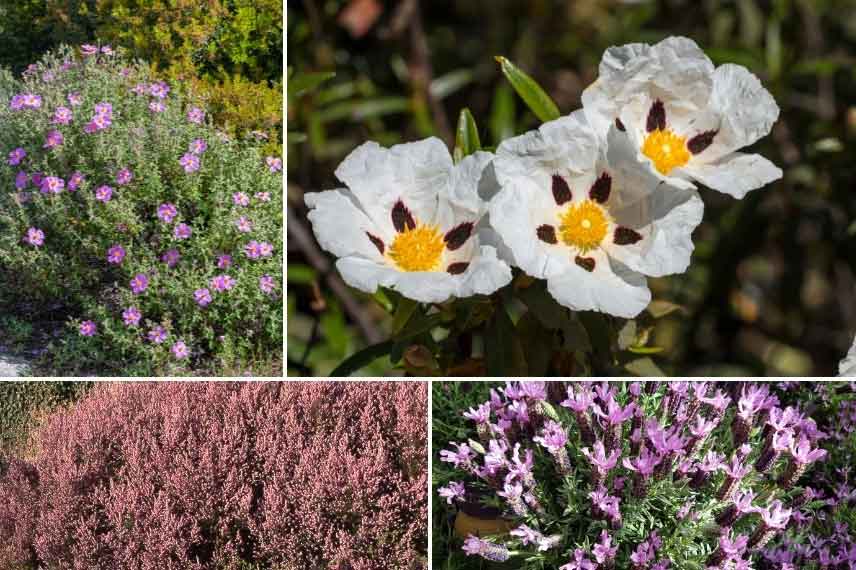
Cistus ladanifer and Cistus creticus in bloom in spring, Erica mediterranea in bloom from January to March, and summer flowering of Lavandula stoechas
On a a bank: Halimium, cousins of cistus
Halimium are cousins of cistus, to which some of them have been linked. They are interesting for their similar cultivation and especially their bright golden yellow or white flowering. They can be planted as groundcover on a slope:
- Halimium ‘April Sun’, a compact evergreen shrub 45cm in all directions, flowering in spring and summer
- Halimium ‘April Snow’, of the same dimensions, with white flowers featuring a bright yellow centre
- Halimium commutatum, slightly taller and wider than the previous ones, flowering from March to May.
On the slopes of this bank or in a dry rockery, they will accompany Teucrium lucidrys, a lovely little evergreen undershrub with violet-pink flowers, the creeping rosemary Rosmarinus officinalis ‘Prostratus’ and the ice plants Delosperma, flowering all summer.

Vegetated slope, white flowers of Halimium ‘April Snow’ and yellow of Halimium ‘April Sun’. Bottom left to right: Rosmarinus officinalis ‘Prostratus’ and summer flowering of Delosperma ‘Wheels of Wonder White’
- Subscribe!
- Contents
































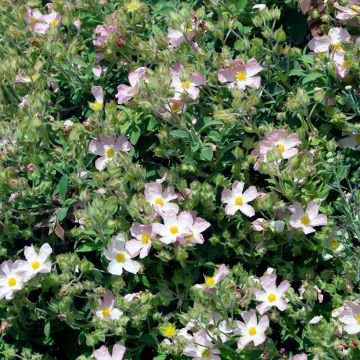
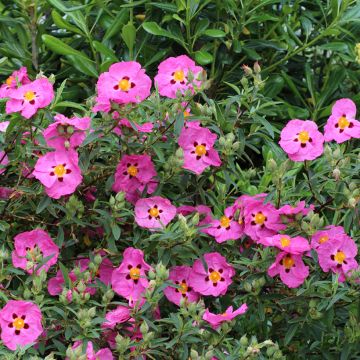
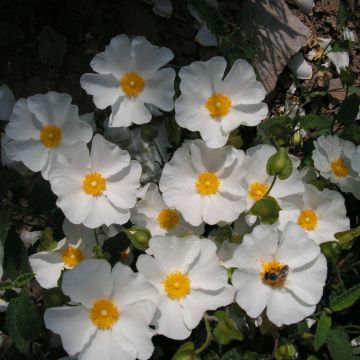
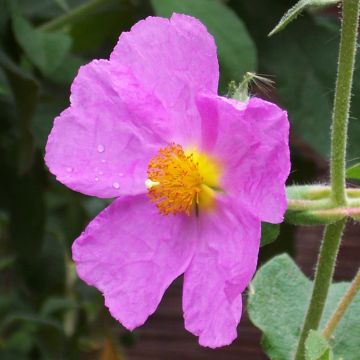
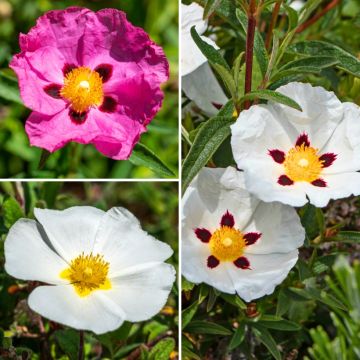




Comments